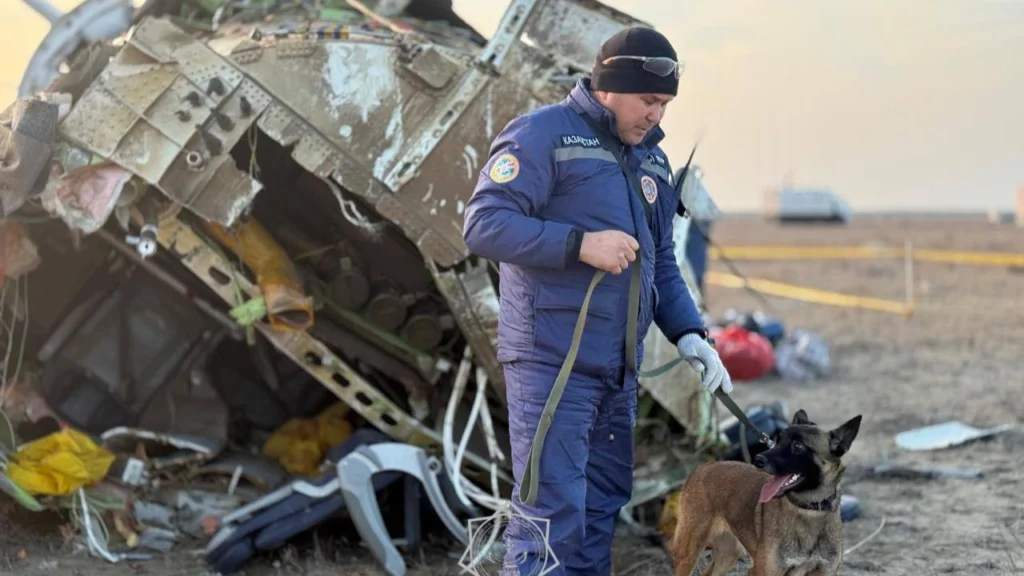AKTAU- The Kazakhstan aviation authority investigates the Azerbaijan Airlines (J2) crash that occurred on December 25, killing 38 passengers and crew members while 29 others survived. Experts examine possible Russian military involvement in the incident.
Details have emerged about the crash’s timeline, potential causes, and survivor accounts. Conflicting reports cite weather issues, drone activity, and even missile interference as factors in the tragedy.

Azerbaijan Airlines Plane Crash
Azerbaijan Airlines (J2) Flight J2 8243, an Embraer 190 aircraft, departed from Baku and was scheduled to land in Grozny, Russia when unforeseen events disrupted the flight.
Reports indicate that adverse weather conditions, including dense fog near Grozny, prompted the pilots to divert toward Aktau, Kazakhstan. Tragically, the plane crashed two miles from Aktau airport.
Witnesses captured the plane’s steep descent on phones, showing its crash and explosion two miles from Aktau airport.
Footage from the scene shows the plane’s rear fuselage lying intact but upside down in a field, underscoring the violent nature of the crash. Aviation authorities have retrieved both black boxes from the crash site.
Officials confirmed the presence of 67 people on board, comprising 62 passengers and five crew members. Among them, 38 lost their lives, while 29 survived.


Different Theories
Aviation officials provide different explanations for Flight 8243’s diversion. Russia’s Rosaviatsia first cited a bird strike, and then officials from both countries pointed to fog in Grozny. Russia later added Ukrainian drone activity as a factor.
Azerbaijan’s President Ilham Aliyev emphasizes weather conditions forced the route change. He states the plane diverted to Aktau airport due to deteriorating weather between Baku and Grozny.
Rosaviatsia chief Dmitry Yadrov reveals that Ukrainian drones targeted Grozny during the flight’s approach, causing airspace closure. The captain attempted two landings in heavy fog before choosing Aktau as an alternate destination across the Caspian Sea.


Russian Missile Theory
One of the theories is that the Russian defense systems target Flight during drone activity over Grozny, with missile shrapnel striking passengers and crew.
Russian authorities deny emergency landing requests at their airports, directing the damaged aircraft across the Caspian Sea to Aktau, Kazakhstan. GPS jamming affects the plane’s navigation systems throughout its sea crossing.
The Azerbaijani news outlet AnewZ reports a Pantsir-S1 air defense system fired the missile, citing government officials in Baku.
Russian sources confirmed their air defense forces engaged Ukrainian drones while the Azerbaijan Airlines flight crossed Chechen airspace.


Investigators Opinion
Three nations – Kazakhstan, Azerbaijan, and Russia – launch investigations into the crash while the Kremlin urges against premature conclusions. Both black boxes have been recovered for analysis.
Early claims from Azerbaijan Airlines (J2) suggested “external physical and technical interference” with the aircraft and suspended flights to Russian airports, though no specifics were provided.
US intelligence sources suggest a Russian surface-to-air missile may have struck the aircraft, raising concerns over Russia’s involvement.
The official states this incident could demonstrate Russia’s reckless behavior in its Ukraine invasion.
National Security Council spokesman, John Kirby, confirms US intelligence indicates possible Russian air defense system involvement while respecting the ongoing investigation by Kazakhstan and Azerbaijan.
Aviation experts challenge the bird strike explanation. Experts dismiss the bird theory, noting birds don’t fly at the altitude where the initial damage occurred.
Independent Russian military expert identifies damage patterns on the plane’s tail consistent with Pantsyr-S1 air defense system shrapnel.
Kremlin spokesman Dmitry Peskov declines to address claims of Russian involvement, deferring to the investigation’s findings.


Survivors Statements
Survivors provide firsthand accounts of the flight’s final moments over Grozny. Flight attendant Aydan Rahimli describes a loud noise triggering oxygen mask deployment, followed by a second bang while treating colleague Zulfugar Asadov.
Asadov reports sounds of external impacts hitting the plane. He suffers a severe arm laceration and contradicts Kazakh officials’ claims about an exploding oxygen canister.
Deep wound, the arm was lacerated as if someone hit me in the arm with an ax…
Zulfugar Asadov, Crew of Flight J2 8243
Two additional survivors, Jerova Salihat and Vafa Shabanova, reported explosions before the crash.
Salihat experiences an explosion near her leg, while Shabanova recounts two explosions in the sky preceding the crash by one and a half hours.
These testimonies align with reports suggesting external damage to the aircraft.
Stay tuned with us. Further, follow us on social media for the latest updates.
Join us on Telegram Group for the Latest Aviation Updates. Subsequently, follow us on Google News

